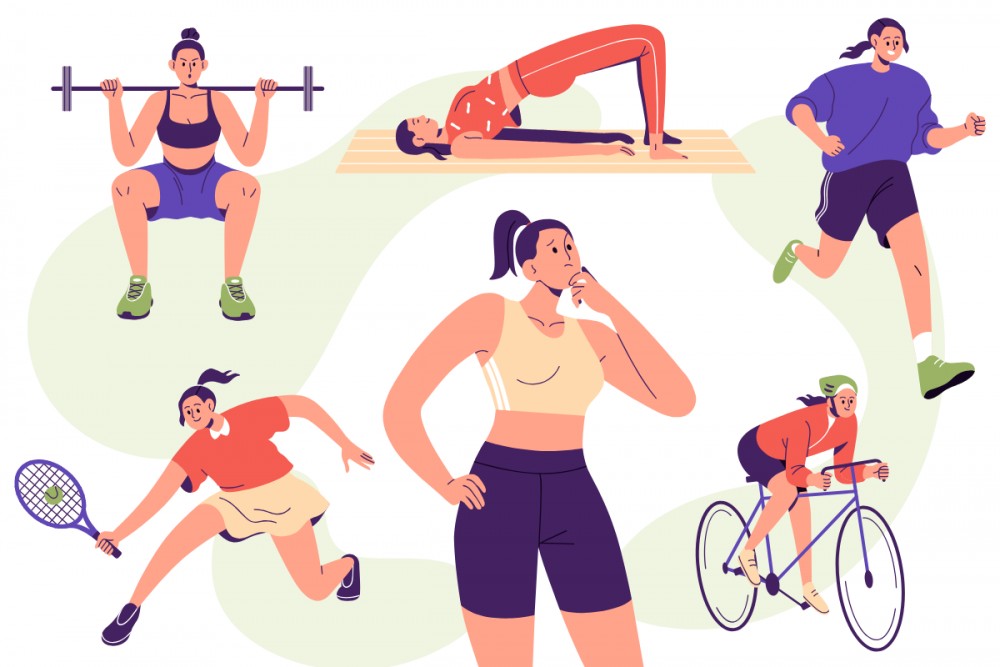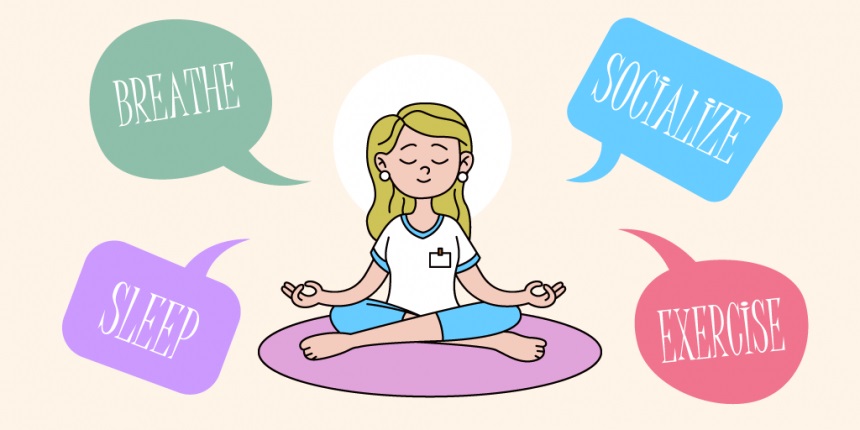Stress has a way of showing up uninvited, doesn’t it? One minute you’re fine, the next your heart is pounding before a big presentation, or your shoulders are tense from a looming deadline. Learning how to relieve stress quickly isn’t a luxury; it’s a crucial skill for navigating modern life. This isn’t about eliminating stress forever, but about having tools to manage it in the moment. Effective stress management starts with these small, immediate actions.
This guide is your personal toolkit. I’ve gathered 15 simple, techniques that can activate your body’s natural relaxation response and bring you back to center in just one to ten minutes. No fancy equipment needed—just you, your breath, and a willingness to find a moment of peace.
Why Quick Stress Relief Matters
It’s easy to think of stress as something you just have to push through. But when you feel that jolt of panic or frustration, your body is kicking off a chemical cascade, flooding your system with cortisol and adrenaline. Interrupting this cycle early is key.
When acute stress isn’t managed, it can settle in and become chronic. This long-term activation of your stress-response system can have serious consequences. Understanding the long-term stress effects on body—from a weakened immune system and poor sleep to higher risks for heart issues—highlights why these quick interventions are so important. They are the circuit breakers that prevent a small spark of stress from becoming a full-blown burnout.
How to Relieve Stress Quickly: Breathing Techniques for Instant Calm
If you only learn one skill for instant calm, make it conscious breathing. It’s the remote control for your nervous system. When you’re stressed, your breathing becomes shallow and rapid. By intentionally slowing it down, you send a signal to your brain that the danger has passed.
This activates the parasympathetic nervous system—your body’s “rest and digest” mode. It’s one of the fastest ways to lower your heart rate, reduce blood pressure, and dial down cortisol. For a deeper dive, exploring different methods of deep breathing for stress management can be incredibly helpful.

Box Breathing (4-4-4-4 Method)
This is a favorite of mine because its rhythm is so grounding. It’s used by Navy SEALs and athletes to stay calm and focused under pressure, so you know it works.
How to do it:
- Find a comfortable seat and gently exhale all the air from your lungs.
- Inhale slowly through your nose for a count of four.
- Hold your breath for a count of four.
- Exhale slowly through your mouth for a count of four.
- Hold your breath at the end for a count of four.
- Repeat the cycle for 1-2 minutes.
4-7-8 Breathing Technique
Developed by Dr. Andrew Weil, this technique is a natural tranquilizer for the nervous system. The extended exhale is the magic ingredient, stimulating the vagus nerve and promoting a deep sense of relaxation.
How to do it:
- Sit or lie down comfortably. Place the tip of your tongue against the ridge of tissue just behind your upper front teeth.
- Exhale completely through your mouth, making a whoosh sound.
- Close your mouth and inhale quietly through your nose for a count of four.
- Hold your breath for a count of seven.
- Exhale completely through your mouth, making a whoosh sound for a count of eight.
- Repeat this cycle three more times.
Diaphragmatic (Belly) Breathing
Many of us are “chest breathers,” taking shallow breaths that don’t fully engage our lungs. Diaphragmatic breathing, or belly breathing, is how we were born to breathe. It maximizes oxygen intake and is incredibly calming.
How to do it:
- Lie on your back or sit comfortably.
- Place one hand on your upper chest and the other on your belly, just below your rib cage.
- Breathe in slowly through your nose. As you inhale, focus on letting your belly rise. The hand on your chest should remain relatively still.
- Exhale slowly through your mouth. Feel the hand on your belly lower as you release the air.
Physical Movement and Exercise
When you’re stressed, your body is primed for a “fight or flight” response. It’s full of energy that has nowhere to go. Physical activity is the perfect outlet. It burns off excess cortisol and adrenaline and, even better, releases endorphins—your brain’s natural mood elevators. You don’t need a full gym session; even a few minutes of movement can completely shift your mental state. Taking advantage of physical activities to reduce stress is a fantastic habit to build.

Quick Cardio Bursts
A short, sharp burst of cardio can work wonders. It gets your heart rate up, processing stress hormones and leaving you feeling clearer and more energized.
Try these for 2-3 minutes:
- Jumping jacks
- Running in place or high knees
- Climbing a few flights of stairs
- A brisk walk around the block or office
Stretching and Yoga Poses
Stress creates physical tension, often stored in our neck, shoulders, and back. Gentle stretching releases this tension and brings your awareness back into your body.
Simple stretches for instant relief:
- Neck Rolls: Gently drop your chin to your chest and slowly roll your right ear toward your right shoulder, then back to center, and over to the left.
- Shoulder Shrugs: Inhale deeply as you lift your shoulders up toward your ears. Hold for a moment, then exhale with a sigh as you let them drop completely.
- Forward Fold: Stand up, and on an exhale, hinge at your hips and let your upper body hang heavy toward the floor. Let your head and neck relax.
Grounding and Mindfulness Techniques
Stress often involves racing thoughts about the past or future. Grounding techniques anchor you firmly in the present moment, interrupting anxious thought loops. They shift your focus from your internal world to your external reality. Think of it as a mental reset button. This is a simple form of meditation for stress management that anyone can do.
5-4-3-2-1 Sensory Grounding
This is my go-to technique when I feel overwhelmed. It forces your brain to focus on the present by engaging all five senses.
Do this right where you are:
- 5: Name five things you can see. (Your computer, a pen, a plant, a crack on the wall, your hands).
- 4: Identify four things you can touch. (The texture of your shirt, the smooth surface of your desk, the warmth of your mug, your own skin).
- 3: Acknowledge three things you can hear. (The hum of the air conditioner, distant traffic, your own breathing).
- 2: Notice two things you can smell. (The coffee on your desk, the scent of hand soap, the air from an open window).
- 1: Identify one thing you can taste. (The lingering taste of your last drink, or just the taste of your own mouth).
Body Scan Meditation
A quick body scan helps you reconnect with your physical self and release tension you might not even be aware of.
How to do it (3-5 minutes):
- Close your eyes and take a few deep breaths.
- Bring your attention to the top of your head. Just notice any sensations.
- Slowly move your awareness down your body—forehead, jaw, neck, shoulders, arms, chest, belly, legs, and finally your feet.
- At each point, simply notice any tension without judgment. As you exhale, imagine that tension melting away.
Sensory-Based Stress Relief Methods
Engaging your senses is a powerful, direct route to calming your brain. Different sensory inputs can trigger comfort, relaxation, and even nostalgia, pulling you out of a stress response.
Aromatherapy and Essential Oils
Our sense of smell is directly linked to the limbic system, the part of the brain that governs emotions and memory. Certain scents can have an immediate calming effect.
- Scents to try: Lavender, chamomile, sandalwood, and eucalyptus are well-known for their relaxing properties.
- How to use: Keep a small bottle at your desk to inhale directly, use a diffuser, or place a drop on your wrists.
Music and Sound Therapy
The right kind of sound can lower cortisol, slow your heart rate, and reduce blood pressure. It’s not just about distraction; it’s about changing your body’s rhythm.
- What to listen to: Try classical music, ambient soundscapes, nature sounds (like rain or waves), or binaural beats designed for relaxation. A 5-10 minute “sound bath” can be incredibly restorative.

Cold Water Exposure
This might sound intense, but it works fast. Exposing your face or wrists to cold water triggers the “mammalian dive reflex.” This physiological response slows your heart rate and redirects blood flow to your core, activating the vagus nerve and producing an instant calming effect.
- How to do it: Splash your face with cold water, hold an ice cube to your wrists or the back of your neck, or if you’re brave, take a quick cold shower.
Progressive Muscle Relaxation (PMR)
PMR is a technique that involves systematically tensing and then releasing different muscle groups. This process helps you become more aware of physical tension and gives you a tangible sense of release.
A simplified 3-minute version:
- Start with your hands and fists. Squeeze them tightly for 5 seconds, then release for 10 seconds, noticing the difference.
- Move to your shoulders. Shrug them up to your ears, hold for 5 seconds, then release for 10.
- Clench your jaw and furrow your brow for 5 seconds, then release for 10.
- Tighten your leg muscles for 5 seconds, then release for 10.
Visualization and Mental Imagery
Your brain often doesn’t distinguish between vivid imagination and reality. You can use this to your advantage by mentally transporting yourself to a place of peace and safety.
How to do it:
- Close your eyes and imagine a place where you feel completely calm. It could be a beach, a forest, or a cozy room from your childhood.
- Engage all your senses in the visualization. What do you see? What sounds do you hear? What do you smell? What does the air feel like on your skin?
- Spend a few minutes fully immersed in this safe space.
Nutrition-Based Quick Fixes
While not a magic bullet, certain foods and drinks can help take the edge off stress.
Dark Chocolate
A small piece of high-quality dark chocolate (70% cacao or more) can be a small comfort. It contains flavonoids that have been shown to help reduce stress hormones. Just a square or two is enough.
Herbal Teas
The ritual of preparing and sipping tea is calming in itself. Certain herbs have properties that promote relaxation.
- Chamomile: A classic for relaxation and sleep.
- Green Tea: Contains L-theanine, an amino acid that can promote a state of calm alertness.
- Peppermint: Can help relieve tension headaches.
Social and Animal Connections
Humans are wired for connection. Brief, positive interactions can trigger the release of oxytocin, a hormone that counters cortisol and promotes feelings of bonding and trust.

The Power of Physical Touch
A simple hug from a loved one can do wonders. Physical touch like holding hands or a reassuring pat on the back has been shown to lower heart rate and blood pressure.
Pet Therapy Benefits
If you have a pet, you already know this works. Petting or playing with an animal is a proven stress-buster. Research shows it can decrease cortisol and boost feel-good hormones like oxytocin and endorphins in just a few minutes.
Cognitive and Mental Techniques
Sometimes, the fastest way to relieve stress is to change your thinking. These techniques help you reframe your mindset and break out of negative thought spirals, which is particularly useful for dealing with stress at work.
Positive Affirmations and Self-Talk
The way you talk to yourself matters. When you’re stressed, your inner critic can be loud. Counter it with simple, positive truths.
Try these:
- “I can handle this situation.”
- “This feeling is temporary.”
- “I am doing my best.”
Humor and Laughter
A genuine laugh is a powerful physical release. It reduces stress hormones and relaxes your muscles. Keep a folder of funny memes, a favorite comedy clip, or a funny podcast on hand for a quick mood boost.
Creating Your Personal Stress Relief Toolkit
The key isn’t to master all 15 of these techniques. It’s to find the 3-5 that resonate most with you and practice them. Experiment to see what works best in different situations.
- At your desk? Try box breathing or a quick stretch.
- At home? Maybe making a cup of tea or petting your dog is best.
- Feeling overwhelmed in public? The 5-4-3-2-1 grounding technique is perfect.
The more you practice these techniques when you’re calm, the more automatic they’ll become when you’re stressed. You are building a toolkit for resilience. And remember, knowing there are different types of stress can help you choose the right tool for the job.
Finding what works for you is a personal journey, and it’s one we explore often over at www.notonetype.org. Taking these small moments to care for yourself isn’t selfish—it’s essential.


You may also like this
Meditation for Stress Management: 11 Proven Techniques
Stress affects millions of Americans daily, triggering physical and emotional responses that can impact overall...
Nov
How to Overcome Decision Fatigue: 10 Proven Strategies to Reclaim Your Mental Energy
Ever get to the end of the day and feel like you can’t even decide...
Nov
Physical Activities to Reduce Stress: Exercises for Mental Well-Being
Feeling overwhelmed? You’re not alone. When life gets hectic, our body’s stress response can go...
Nov
Stress Management: Proven Strategies to Reduce Stress and Improve Wellbeing
Stress is a universal human experience. It’s that feeling of being overwhelmed when your to-do...
Nov
Deep Breathing for Stress Management: Techniques to Calm Your Mind and Body
Breathing. It’s the first thing we do when we enter the world and the last...
Nov
Stress at Work: Causes, Signs, and Proven Strategies to Manage Workplace Stress
Stress at work affects millions of employees worldwide, leading to decreased productivity, health problems, and...
Nov